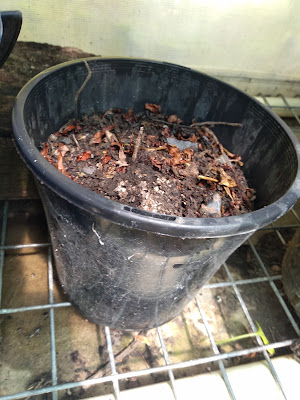A few years ago we bought some Pineberry strawberry plants. Pineberry are an old variety of strawberry that are a little different.
Pineberry is a very old variety that is said to be a hybrid of two species of strawberry, the South American Fragaria chiloensis, and the North American Fragaria virginiana but they may also have other species in their heritage and probably some back crossing.
 |
| Pineberry strawberries |
Pineberry are not F1 hybrids, they are not GMO, they are an older variety that was produced by normal cross pollination. While I say they are not F1 hybrids, this does not mean their seedlings will be anything like the seed parent. Pineberry are hybrids of hybrids, their seeds produce a wide range of diverse traits.
Most fruit are interspecific hybrids of several species, and all garden strawberries (Fragaria x ananassa) are a hybrid of several species. This means the fact that Pineberry are a combination of various strawberry species is of no concern.
 |
| Pineberry strawberries |
I am unsure of pineberry's ploidy level. Given that I don't plan to do any breeding work with pineberries, this does not pose an issue. The seeds are viable, if planted they will not produce a pineberry, they will turn out to be a wide variety of different strawberries.
It would be simple to breed a new variety of strawberry using pineberry as the seed parent. Bag the flowers, transfer pollen from a different variety that has traits you like (such as larger fruit, day neutral, etc), and grow out the seeds. You will know that it hasn't self pollinated as the plants are all female.
 |
| Pineberry are smaller than garden strawberries |
Unlike most garden strawberries, Pineberry strawberries only produce female flowers. They need another variety of strawberry near by to act as a pollinator. Most home growers tend to have more than one variety of strawberry, so this isn't an issue.
The choice of pollinator won't affect the colour or the taste or look of the berries, so you don't need to worry about planting the wrong one. Even if you don't have another strawberry variety, if you have a small block in town surrounded by neighbours there is a high chance one of them is growing strawberries, and insects happily (or to be more accurate, accidentally) transfer pollen for you.
Pineberry can not be grown from seed. They are female plants, and any seed produced will be the result of pollination from a different variety. Luckily they produce many runners and are simple to propagate.
 |
| Pineberry can be reasonably productive |
Pineberry can be relatively productive, they produce numerous flowers which can turn into berries.
Sadly, they only flower once or twice per year. Pineberry are what is often referred to as 'June Bearing', a term comes from the Northern Hemisphere. In Australia pineberries have one main flush of fruit which often ripens around November to December in my garden. They can have a second flush of flowers or even a third some years, but this is not a given.
 |
| Pineberries |
Pineberries can also flower profusely, and then abort all the flowers to produce no fruit. I believe this is due to lack of pollination, or a lack of water.
All strawberries need additional water to produce fruit in my garden.
If no other strawberries are flowering nearby the fruit all aborts as pollination cannot occur. I grow a bunch of different varieties of strawberry, so there is a good chance one of them will flower at the same time as pineberry and I can get a decent crop.
 |
| Pineberries are a little small |
Pineberries produce berries that are white with red achenes (achenes are the things on the outside that people call seeds, the seed is inside this structure). They are light green/white when unripe, it is easy to know when they are ripe as they get a pink blush. If you cut one open, they are white all the way through.
The taste and smell is reminiscent of pineapple, and they can be very sweet. Occasionally mine taste sour and uninteresting. I think this is due to lack of water or perhaps temperature fluctuations. I don't tend to water my pineberries often, and I regret it when they fail to fruit well that year.
 |
| Pineberries ripening |
The berries themselves are noticeably smaller than garden strawberries. Back when pineberry was easy to buy from nurseries or online everyone conveniently neglected to inform buyers of this fact.
I have included a few photos of them next to garden strawberries for a comparison. The comparison strawberries are a small-medium berry from a variety known as Melba.
 |
| Melba and Pineberry |















































